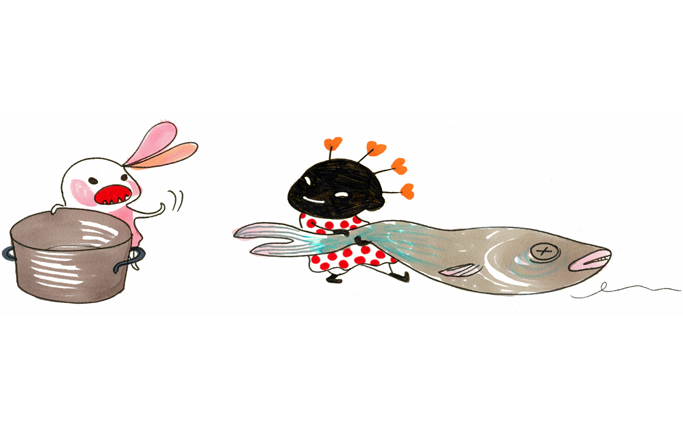
In keeping with some of the consistent preoccupations of this forum, I figured I’d try to convey aspects of cultural discourse around comics and cartooning and their treatment of deeper social issues in my corner of Europe, Scandinavia. I think seeing these issues of art as polemic; racism; and freedom of expression as manifested in a, to many, largely unfamiliar context might be interesting, and it will certainly be helpful to me to hear the perspectives of the Hooded Utilitarian’s international, predominantly American readership.
Brokiga trailerHD 2012-08-14 leefilm from Linda Hamback on Vimeo.
I
A place to start would be this fall’s media controversy in Sweden, about blackface and pickanniny characterization in a popular series of children’s books with the character Lilla Hjärtat (‘Little Sweetheart’), by Stina Wirsén—a controversy that has recently led Wirsén to decide to withdraw the books from the trade and never draw the character again.
Wirsén has been writing and drawing books about Lilla Hjärtat for a couple of years, releasing six books that together have sold over 40,000 copies—a considerable number in Sweden. Meant for young children aged 0–3 or so, the central character is a little black girl, undeniably drawn in the tradition of the American pickaninny, with big lips and bows tied into her nappy braids.
No one seems to have complained in public about the books until September 21, when an animated film version, entitled Liten Skär och alla små brokiga (‘Little Pink and all the small multi-colored ones’, trailer above), opened in Swedish theaters. The added exposure afforded by a film made a number of people, including several prominent cultural critics and cartoonists, take notice.
Amongst the most vocal have been freelance writer and critic Oivvio Polite, who has helpfully provided an English-language summary of the controversy with pertinent excerpts of interviews and op-ed pieces translated for non-Swedes. In short, the media rollout of the film spurred discussion online—on Facebook, Twitter and elsewhere—among other things about the fact that nobody seemed to question or even address the film’s stereotyped imagery.
This controversy quickly migrated to the mainstream media, touching off a wider discussion of how best to handle problematic imagery, not the least that of earlier eras, and about Swedish children’s culture, with critics pointing out the conspicuous, general absence of non-white characters in Swedish children’s books and entertainment.
The film distributor, Folkets bio, initially denied any wrongdoing, insisting on the film’s humanist and multiculturalist message, arguing that Swedish culture has reached a point where it ought to be possible to ‘stylize’ dark-skinned people in the same way other groups are stylized. Although individual theaters declined to show the film, Folkets bio has stood its ground, retracting (somewhat bizarrely) only the poster. As mentioned, the pressure however eventually became too much for Wirsén and her publisher Bonnier, who have now retracted the books featuring Lilla Hjärtat, apparently with a view to pulp their stock, while Wirsén herself declared on 22 November that she will never draw the character again.
Wirsén and her publisher have maintained all along that her intent was in fact the opposite of what her critics were seeing in the work, namely to promote a multicultural and open vision for children. In her October 23 press release, she further somewhat implausibly denies having taken a cue from the pickaninny or golliwog stereotypes, pointing rather to African and Carribean imagery. In a November 22 op-ed piece for the newspaper Dagens nyheter, for which she has worked since 1997, she further writes:
The controversy… has demonstrated that there are many ways of interpreting Lille Hjärtat. Most people have seen her as she was intended: as a positive and strong, independent character—an exemplar. But there are also people who have interpreted her negatively. She has been attributed a set of traits implying that she—and I—suffer from an outlook and understanding to which I cannot relate and with which I most definitely do not want to be associated.
Joanna Rubin Dranger, one of Sweden’s premier cartoonists and professor of storytelling at the art school Konstfack in Stockholm, as well as Polite’s partner, has also joined the debate. She has emphasized in particular that a cultural product can be racist even if the author’s intentions are not, writing:
How can you represent a (whole) human being if you’re unable to reflect over what is a normative or reductive characterization? How can one avoid being homophobic, misogynist, or racist in one’s picture-making if one isn’t familiar with the visual discontents of how individual groups have been characterized historically?
She and Polite have engaged themselves in the case to such an extent that they have involved their children, who appear on a special webpage “We Are Not Your Motley Crew” holding up protest signs, along with other people. Seeing them and corresponding with Polite spurred an American professor, John Jennings of the University at Buffalo, to enter the debate. He calls Wirsén’s images “obviously racist” and calls for a total retraction of both books and film. He understands that Wirsén’s intentions were different, but notes that one cannot simply use stereotypes like that, “We think we can repossess them, but it is hard to change their meaning. Stereotypes don’t change.”
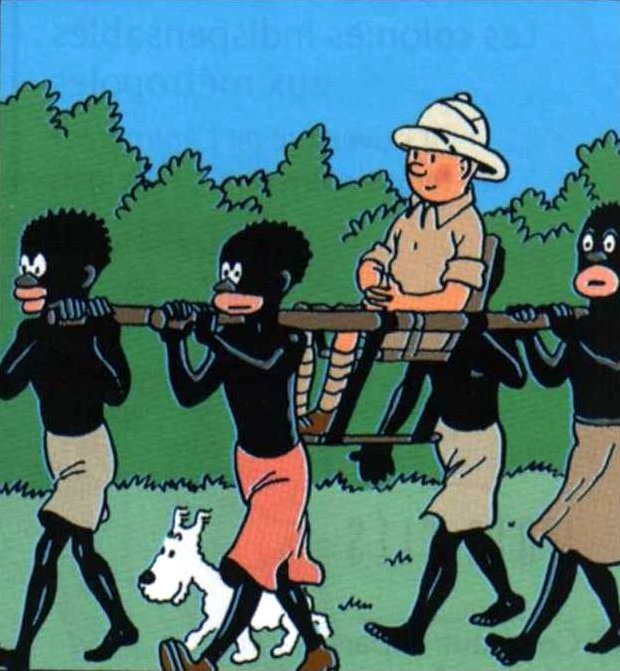
From Tintin in the Congo (1946 edition)
II
While the controversy was raging in September, a related one concerning Hergé’s infamous Tintin in the Congo flared up at the library of Kulturhuset in Stockholm (which incidentally also houses the great comics library Serieteket). Librarian in the children’s/youth section, Behrang Miri, announced in late September his intention to move Hergé’s book and other potentially offensive material to the adult section of the library. This triggered strong protests, not least in the media, with different critics arguing that it would be impossible to determine where one would draw the line, in that most material from earlier times—going back to the Bible and the Koran—contain passages that some find offensive. And further that reclassifying the books would have the opposite effect of what was intended, being a form of censorship that would contribute to a whitewashing of European cultural history. The criticism made Mihri reconsider his decision and the books stayed where they are.
From an international perspective, this debate might be interesting for a number of reasons. For one, it demonstrates how differently racist stereotypes of black Africans are perceived in the historically very culturally and ethnically homogenous Scandinavian countries, where until fairly recently people of sub-Saharan African descent were a rarity. Needless to say, Lilla Hjärtat would be unthinkable in the contemporary United States, and indeed in most of the larger Western European countries. Jennings’ reaction clearly demonstrates this: unfamiliar with the cultural context in which these images have been produced, he applies an American eye, unsurprisingly finding them beyond the pale. A misunderstanding? Perhaps, but also one of the conditions of the globalization of media.
III
Clearly, people at large in the Scandinavian countries tend to be much less sensitive to such imagery than in large parts of the rest of the Western world. Another recent example of such reconfiguration in Sweden was a rather grotesque art installation displayed at Moderna Museet in Stockholm on World Art Day on April 15 of this year. It featured a giant cake made to look like a mostly nude stereotypically “native” African woman, offered to the attendees. The Swedish minister of culture Lena Adelsohn Liljeroth, a special guest at the event, cut the cake from its vaginal region, offering slices to people, while the artist Makode Aj Linde, hidden under the table with his head inside the mask attached to the cake as its “head,” screamed in mock agony. Liljeroth even fed a piece to Linde through the mask. Other people then started serving themselves. (See video above — Liljeroth doesn’t appear in it, but she’s in the photo below. And here’s a rundown of the events for easy reference).
The event caused outrage: first a fake bomb threat was phoned in to the museum, although it is unclear whether it was a reaction to the cake; then a media storm kicked off, headed by the National Association of Afro-Swedes (NAFA) and the Swedish Center against Racism, both of which protested it as a disturbing and tasteless racist spectacle, calling for the minister to resign.
It is hard to see such a manifestation taking place in the United States or the UK, or at least to imagine a prominent government representative or minister officiating in the rather oblivious way Liljeroth did. After the event, she explained that she was there to speak for the right of artists to provoke, but also that she had been asked to cut the cake before having seen it and never intended to offend anybody. This is a strikingly wishy-washy reaction revealing a rather tone deaf grasp of the situation from a minister of culture. More generally, it bespeaks the general obliviousness in the Scandinavian countries to the issues involved. As Mariam Osman Sherifay of the Swedish Center against Racism put it:
In Sweden, it seems to be comme il faut to caricature Africans in ways we could never imagine portraying other ethnic groups which have been persecuted: for example Jews, Romani or Saami people. Still in the 21st century we haven’t dealt with the stereotypical notions of Africans that seem to have been passed on by heredity in Swedish mentality.
The artist, a Swede of African descent, has long been exploring blackface imagery and racial stereotypes in his work and felt that these critics misunderstood his intent, which was to highlight the problem of female genital mutilation. One senses that he also wished to expose precisely the kind of cultural obliviousness around African stereotypes that Sherifay mentions, or—as he stated—to expose “different forms of oppression” simultaneously. He certainly succeeded, if by somewhat dishonest guile: it seems probable that Liljeroth and the other guests were taken somewhat aback and that their laughter in part was an uncomfortable one. But the images of the lily-white Swedish cultural establishment merrily cutting into a mock African tribeswoman remain kind of indelible, and indeed quickly went global.
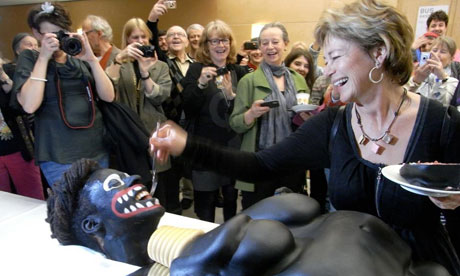
Swedish minister of culture Lena Adelsohn Liljeroth feeds artist Makode Aj Linde
IV
These controversies demonstrate that the status quo is changing: minority groups have risen in number in recent decades, not least in Sweden, which has the biggest minority populations in Scandinavia. This naturally makes indiscriminate use of stereotypes a much more sensitive issue than it used to be. But just as importantly they raise issues of free speech and civic responsibility in a multicultural society. What Sherifay says is clearly true to a certain extent, but things are more complicated than that. Sweden is not simply the haven of ignorance and chauvinism, where “racism is just a joke”, as she and other critics such Jallow Momodou of NAFA would have it.
It is, rather, a country that prides itself on the communitarian ideals embodied in its social democratic state and in its socially liberal attitudes—attitudes that sometimes result in rather coarse insensitivity. It is worth noting that the initial rebuttals provided by Wirsén and Folkets bio, however wrongheaded, demonstrate their belief that stereotypes can be repossessed and harnessed to address cultural discourse in more nuanced ways and ultimately to fight prejudice. This is quite typical of a culture in which such stereotypes were never particularly concrete in the first place, and while the results might range from the naïvely boorish to the outright offensive, there is also an argument to be made that such cultural misappropriation might indeed occasionally offer new, useful perspectives.
A case in point would be the infamous cartoons of the prophet Muhammad, published in 2005 in the neighboring country (and my home), Denmark. A prime example of local discourse going global and mutating beyond recognition on a much larger scale than the recent Swedish controversies, it started as a mean-spirited (but also ambiguous) stunt by a conservative newspaper, Jyllands-Posten, which was actually met with a lot of criticism locally before the flames were fanned by a small group of unprincipled Danish imams in particular and it hit a nerve internationally, taking on much more ominous and complex dimensions.
Whatever one might think of their ideological content or aesthetic value, the cartoons— not the least the most infamous one, the so-called “Bomb in the Turban”—exposed crucial cultural fault lines in our globalized world. For better or worse one might say, but it is hard to deny the way they have illuminated a certain set of issues that we ignore at our peril. As much as they have become emblematic (however hyperbolically) of Western hegemony and orientalism to many, they have become a symbol (however coarse) of freedom of speech to just as many. A sad, but potent exponent of international tendencies of polarization the temperance of which remains frustratingly elusive, because infinitely more complex than the simplistic us vs. them discourse they have primarily engendered.
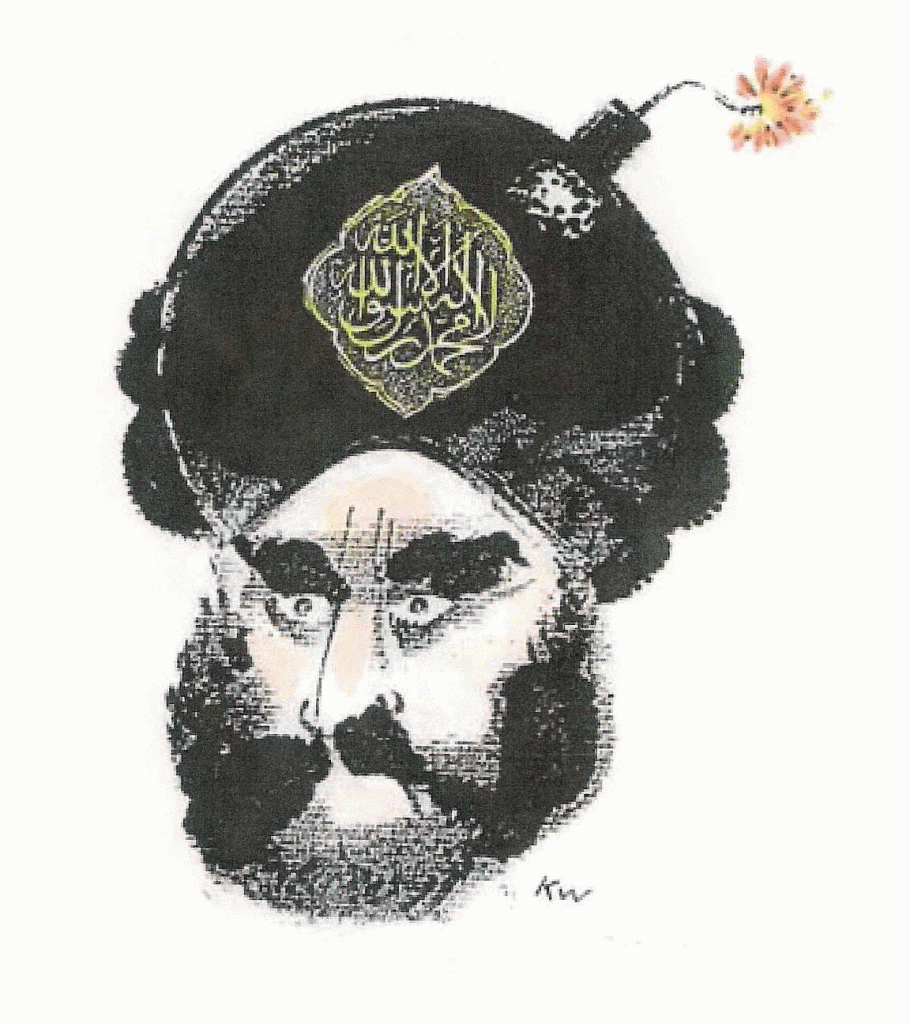
V
Although clearly made in a different, smaller, and much less explosive context, something similar could perhaps be said for Makode Aj Linde’s installation, and possibly even Lilla Hjärtat. Certainly some black commentators, including Linde who has supported Wirsén, have stressed that the critics of these cultural products are not speaking for them, and in fact seem to have misunderstood their point. However one wants to take that, the controversies around these works are clearly nestled in a local cultural discourse split between mindfulness of cultural difference and insistence on what is perceived as fundamental civil liberties.
As insensitive as the Swedes might seem in these particular cases, the country is—along with the other Scandinavian countries in different measure—also characterized by a very strong consensus culture, dominated to a large extent by what one might call political correctness. Critics argue that this consensus culture has reached a level of pervasiveness where it is actually harmful, leading to censorship of unwanted ideas and victimization of the minorities who need to be “protected” against them. Additionally, there is an increasing wariness against feeding the ‘culture of victimhood’ that has emerged with globalization—and which was catalyzed by the so-called ‘cartoon crisis’—where individual communities seek to raise their profile on the basis of perceived offenses against them against which they demand action to be taken.
There is a risk that the resultant controversies end up at best being distractions from the very real problems with racism, bigotry or cultural hegemony present in our societies, and at worst actually feeding these by polarizing our societies unnecessarily. The cartoon crisis is a depressing case in point: while it was an eye-opener in many ways, it has ultimately consolidated opposing camps, with the middle ground steadily eroding.
The Swedish actor Stellan Skarsgård, who narrates Liten Skär, surely does not express a fringe sentiment when he says of its critics that they ought to concentrate on real racists instead of attacking this film. The implication being that confusing something comparably innocuous like Lilla Hjärtat, anti-racist in intent if not form, or Linde’s provocative and ambiguous work, with full-blown racism, as Momodou for example does in his piece quoted above, is detrimental to efforts to combat the latter. Sweden has long had a serious problem with racially motivated violence perpetrated by extreme right-wing groups, and there is an argument to be made that the politically correct consensus culture has contributed to this.
By comparison, the political establishment in Denmark, driven by the success of the populist Danish People’s Party, started successfully integrating strong anti-immigration rhetoric into the political mainstream as early as the nineties, whereas in Sweden their equally disagreeable pendant, The Sweden Democrats, were only elected to parliament in 2010. The rise of the Danish right may have led to some of the most draconian immigration laws in Europe, but it has arguably also helped defuse extreme right-wing racial violence, which has never been a comparable problem there.
Of course, Denmark has reaped its own whirlwind after the cartoon crisis, which at least in part needs to be understood in relation to the country’s immigration and integration policies (although Sweden has had its own very similar problems since artist Lars Wilks drew the prophet Muhammad’s face on a dog in 2007). The presence of both international and domestic Islamic terrorists on Danish soil is a new, uncomfortable reality in a country that perceives itself as peaceful, open-minded, and safe. The co-plotter of the 2008 Mumbai attack, David Headley, who scouted the Jyllands-Posten newspaper headquarters in 2006 with an attack in mind; Muhamed Geele, who on New Year’s day 2010 invaded the house of cartoonist Kurt Westergaard, unsuccessfully attempting to chop him up with an axe; and the foiled 2010 Swedish/Tunisian plotters against Jyllands-Posten. These are only the most conspicuous of a longer list of unwelcome guests, whose motivations to seek Danish targets is directly tied to the cartoons.
And events in Norway in the summer of 2011 have taught us all about the threat of right-wing extremism. It is unreasonable to attribute the atrocious mass murder perpetrated by Anders Behring Breivik directly to any specific outside factor, but the facts remain that his delusions of a Norway under threat from multiculturalism tied into the issues at stake here and drew upon extreme right-wing anti-immigration discourse, making it all the more important that we pay attention to how such discourse is shaped. And if we cannot do it in art, then where?
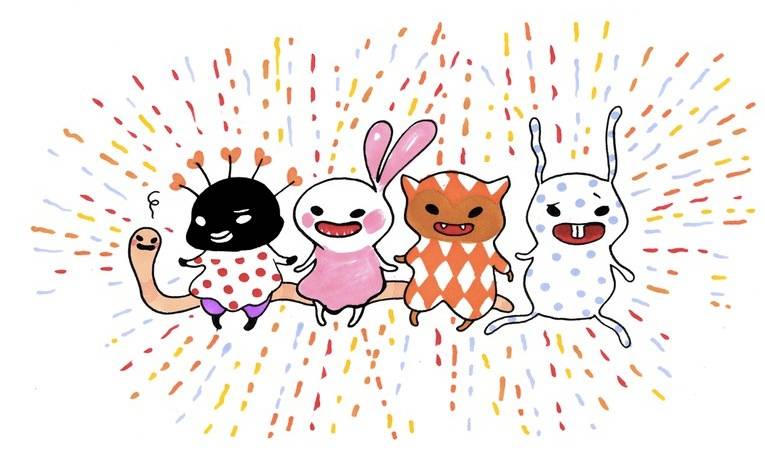
VI
A fundamental question is how harmful the kind of art we are dealing with here is—a question closely tied to the context of their production and presentation to the public. One issue, as mentioned, is that context is open-ended: you cannot make socially, politically, or culturally engaged art without engaging specific contexts, and doing so today exposes you to the risk of immediate appropriation in very different contexts around the world, with the original intent being lost in translation. Even locally, context makes all the difference: for Jennings, for example, Linde’s installation is fully acceptable, because it was made in a high-art context, whereas Lilla Hjärtat and Tintin in the Congo are meant for children and are therefore not. We also generally allow greater leeway for satire than other forms of humor, even though both satire and humor are more often than not dependent on a certain measure of stereotyping to work.
Most civilized countries have laws against hate speech, but the problem is how one defines this term, and to what extent one is willing to curtail freedom of expression in order to silence perceived perpetrators. Surely everybody has their limits on what is acceptable, but if the controversies these last years have shown us anything, it is that one man’s hate is another man’s free. Personally, I have found much of the provocative art—or “art”— engaging these issues in the last half decade tasteless and unnecessary, at times times even abominable, but I hesitate to advocate for legal suppression. It is vital that we keep our societies open and tolerant, especially when faced with the kind of challenges to individual liberty we are seeing today. No matter what somebody believes, says, writes, or draws, it is unacceptable that they should fear for their life or their freedom of movement.
Freedom of expression is not only a right, but also a civic responsibility. If something offends you, speaking up against it, like NAFA and others have done in the cases mentioned here, is a vital function of a free society. As is noting that such criticism is misguided or perpetuates an unhealthy culture of vitctimhood. It pains me to see an artist so shocked by the reactions to her well-intentioned work that she decides to retract it, just as it does once again to have confirmed just how insensitive we can be to certain minorities in our little Scandinavian monocultures, but as long as we stay within the bounds of civilized discourse, it is ultimately healthy for us all.
Appendix: For those interested in getting more of an impression of the debate as it was unfolding in Denmark at the time, here are two pieces I wrote about the Muhammad cartoons, one when as the crisis proper was still brewing and one when it was at its peak.
